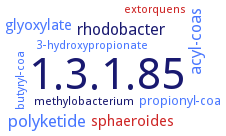1.3.1.85: crotonyl-CoA carboxylase/reductase
This is an abbreviated version!
For detailed information about crotonyl-CoA carboxylase/reductase, go to the full flat file.

Word Map on EC 1.3.1.85 
-
1.3.1.85
-
polyketide
-
rhodobacter
-
acyl-coas
-
glyoxylate
-
sphaeroides
-
propionyl-coa
-
3-hydroxypropionate
-
extorquens
-
methylobacterium
-
butyryl-coa
- 1.3.1.85
- polyketide
-
rhodobacter
- acyl-coas
- glyoxylate
- sphaeroides
- propionyl-coa
- 3-hydroxypropionate
- extorquens
-
methylobacterium
- butyryl-coa
Reaction
Synonyms
2-octenoyl-CoA carboxylase/reductase, AntE, CCR, CCR1, CCRC, crotonyl-CoA carboxylase/reductase, crotonyl-CoA reductase (carboxylating), crotonyl-CoA reductase-carboxylase, ECR, enoyl-CoA carboxylase/reductase, pteB, rimJ
ECTree
Advanced search results
Engineering
Engineering on EC 1.3.1.85 - crotonyl-CoA carboxylase/reductase
Please wait a moment until all data is loaded. This message will disappear when all data is loaded.
E171A
the mutant shows reduced activity compared to the wild type enzyme
F170A
in the mutant, the carboxylation activity is decreased to 17% at the expense of increased reduction side reactivity compared to the wild type enzyme
F170Y
the mutant shows a slightly increased substrate inhibition, but otherwise very similar kinetic parameters as the wild type enzyme
H365N
the mutant shows a 20fold decreased activity compared with the wild type enzyme but still displays 93% of carboxylated product, even though the KM for CO2 is raised by more than 1 order of magnitude
N81L
the interaction of the enzyme with CO2 is severely disturbed by the N81L mutation. Stereospecificity of butyryl-CoA formation is almost completely lost in the mutant compared with the wild type enzyme
S119A
the mutant shows almost full carboxylation, but at more than 50fold reduced turnover frequency as compared to the wild type enzyme
T82D
the mutant shows almost full carboxylation, but at more than 50fold reduced turnover frequency as compared to the wild type enzyme
E171A
-
the mutant shows reduced activity compared to the wild type enzyme
-
F170A
-
in the mutant, the carboxylation activity is decreased to 17% at the expense of increased reduction side reactivity compared to the wild type enzyme
-
H365N
-
the mutant shows a 20fold decreased activity compared with the wild type enzyme but still displays 93% of carboxylated product, even though the KM for CO2 is raised by more than 1 order of magnitude
-
N81L
-
the interaction of the enzyme with CO2 is severely disturbed by the N81L mutation. Stereospecificity of butyryl-CoA formation is almost completely lost in the mutant compared with the wild type enzyme
-
S119A
-
the mutant shows almost full carboxylation, but at more than 50fold reduced turnover frequency as compared to the wild type enzyme
-
A182L
the mutant with increased activity selectively catalyzes carboxylation over the regular reduction reaction
V350A
the mutant shows increased activity compared to the wild type enzyme
V350F
the mutant shows increased activity compared to the wild type enzyme
V350G
the mutant shows increased activity compared to the wild type enzyme
A182L
-
the mutant with increased activity selectively catalyzes carboxylation over the regular reduction reaction
-
V350A
-
the mutant shows increased activity compared to the wild type enzyme
-
V350F
-
the mutant shows increased activity compared to the wild type enzyme
-
V350G
-
the mutant shows increased activity compared to the wild type enzyme
-


 results (
results ( results (
results ( top
top






